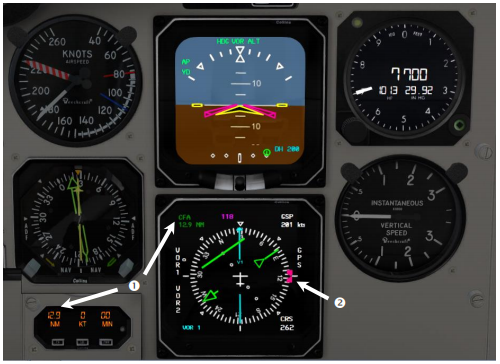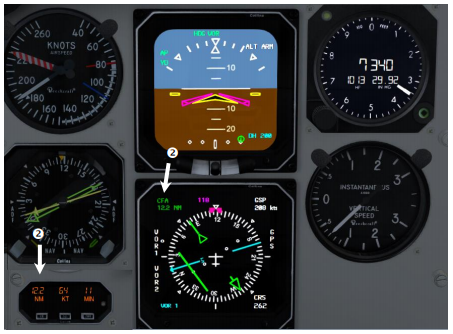¶ Preparatory work
¶ Scenario
You will need to open the following charts of Clermont Ferrand airport LFLC in France:

We will be flying the ILS V RWY26 via SOMTI IAF. We will arrive at radial 208° inbound CFA.
¶ Lateral flightpath management
We will be flying a 12NM arc from radial 208° to radial 082°(heading 262°) of 114.35MHz CFA VORDME.
- Entry: Radial 208° at 14NM DME of CFA VOR at 7700ft.
- Exit: Radial 090° 12NM DME of CFA VOR at 4500ft.
- Target is to establish the ILS approach of runway 26 frequency 111.10MHz course 262° at 3460ft.
We need to determine entry and exit anticipation.
In order to be at ease, we need to calculate the various headings that we will be using and to execute our anticipation techniques.

In this example we will be flying a ground speed of approximately 200kts.
Since we are on the VORDME radial, DME reading can be used for entry anticipation.
On the contrary, DME reading cannot be used for exiting the arc as we will be flying perpendicularly to the VORDME radials. We will then use an anticipation radial.
Using the various formulas at our disposal, we can calculate:

About the last segment, we will try to be as close as 90° to the exiting radial. Here for example, we will round the 358° track to 352° track. It will not impact much the arc and will ensure an accurate anticipation.
Therefore, we can deduce that:
- Entry of the arc will be initiated at D13 CFA (13NM DME of CFA VOR)
- Anticipated exit will be initiated on radial 086° of CFA VOR
- First turn heading will be 118°
- In-sequence segment tracks: 088° / 058° / 028° / 352° (30° steps)
¶ Vertical flightpath management
During our DME arc, we will need to descend according to the vertical profile procedure.
- From FL77 to FL65, between radial 198° and radial 168°.
- From FL65 to 4500ft, between a radial to be determined, and radial 090°
As the descent steps are long and the altitude to lose is less than 2000ft, we plan on descending onto a 2° path, giving us approximately a vertical speed of -700ft/min at 180KT.
The day QNH is 1032hPa, Transition Level is FL60.
From radial 198° to radial 168°, the arc distance is: 30 × 12 / 60 = 6 NM
From FL77 to FL65, we have 1200ft to lose, leading to a 6NM-long descent, the 2° path is perfect and the descent will be initiated by radial 198°.
From FL65 to 4500ft, 1032hPa QNH setting will result in an additional 550ft to lose of the wanted 2000ft.
The descent at 600ft/min at 180Kt should be 13NM long. It represents an angle of: 60 × 13 / 12 = 65°.
Since we are targeting the altitude at the end of the arc (radial 90°), we propose to initiate our descent on radial 90°+65°=155° for training purposes.
The procedure profile authorises you to descend when crossing radial 168°, but the constraint is the same: you must reach 4500ft altitude when crossing radial 090° at the end of the DME arc.
¶ Flying the DME arc
¶ Before joining the arc

Here is the initial situation:
- Stable at FL77, established onto radial 208° CFA at 23NM, which means we are above SOMTI.
- VOR 1 and VOR2 is set at 114.35MHz for CFA ( ILS-DME 111.10MHz CF in VOR1 stand-by)
- DME is set to VOR 1, receiving CFA DME. RMI 1 is set to VOR 1.
The next step will be to prepare our aircraft to join the arc:
- 5NM before the DME arc, set the course (262°) to the exiting radial 082° (intermediate approach track towards FAP CF NDB)
- Check your instruments are ready and operational.

¶ Joining the arc
Now, await the anticipation turn distance at 13NM DME:
- Monitor the decreasing DME value
- Slightly before 13NM DME of CFA VOR, initiate your turn to heading 118°

Keep in mind the DME arc following rule for arc radius below 20NM:
As soon as the DME deviation is more than 0.2NM, a 30° heading change should be made.
This heading change will allow the DME distance to decrease no more than 0.5NM before increasing again.

¶ First segment
When established onto track 118°, if anticipation is well calculated, you should read on the DME 12NM from CFA. You should make sure the DME distance increases.
If you are above 12.2NM, immediately initiate a 10° heading turn (108°) to correct the track and make sure the DME distance begins to decrease.
If the DME distance still does not decrease below 12.2NM, continue to correct by adjusting your heading (no more 10° per 10°).
Monitor distance DME:
- You should notice the DME distance is below 12.2NM
- Await DME increasing again up to 12.2NM
- When CFA is further than 12.2NM, set heading to the next segment (098°)
- On radial 198°, begin your descent to FL65. We have targeted a 2° path which gives us roughly -700ft/min

Rule:
As soon as the DME deviation is more than 0.2NM, a 30° heading change should be made.
This heading change should allow the DME distance to decrease below 12.2NM no more than 11.5NM before increasing again.
Do not forget to manage your vertical position! Monitor both vertical situation and horizontal situation.
¶ Second segment

We are now ready to turn:
- Notice that DME distance is increasing
- Check that we reach 12.2NM
- Initiate a 30° turn after reaching 12.2NM - left turn toward 098° - (not shown on image and should be the next action)
Do not forget: if DME distance still not decreases or is still too high after a heading change; apply a 10° corrective action.
¶ Third segment
On the next picture, we are flying the 3rd leg:
- We are at 058° heading
- We are currently crossing 155° radial
- We shall start to descend now in order to reach the expected target using -700ft/min descent rate.
- We just changed to the local QNH after beginning our descent which gives us the expected 550 feet to lose on the altitude (6500+550=7050)
- DME distance is now 12.1NM. It is near the time to join our next DME arc segment (028°)

¶ Turning to the last segment

On the next picture, we are turning towards the last leg:
- We have reached the 12.2NM target
- We initiate the last leg stated 352° (perpendicular to the exit radial or intermediate approach track at 262°)
- We monitor the descent towards 4500ft at -700ft/min
¶ Exiting the arc

Our last segment shall bring us perpendicularly to the exiting radial that we set earlier (262°):
- As we calculated, we should initiate our turn at anticipation radial 086°
- Target altitude at 4500ft has been reached
- Since our arc will lead to an ILS interception, we switch the ILS on the HSI shortly before exiting the radial in order to prepare the approach
- We can still track the radial position thanks to the RMI, and DME distance on the second DME.\
This manoeuvre will allow us to establish onto the desired exiting radial and the whole procedure allowed us to join the final phase of our ILS approach, safely.
On the next image, we are established on the final approach track.

¶ Flightpath

- None
- VID 200696 - Creation
- VID 496402 - Wiki.js integration